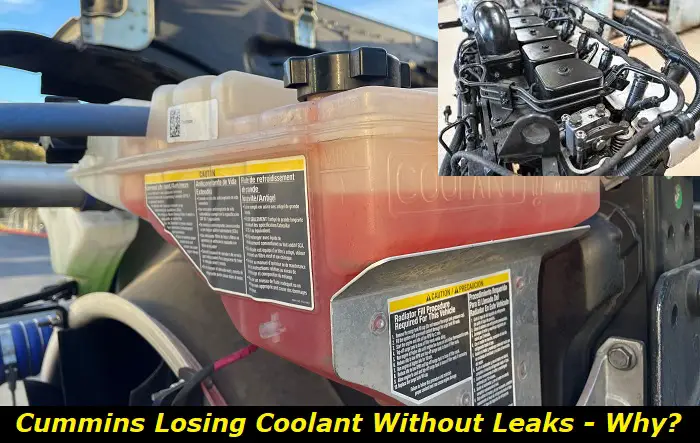Cummins Losing Coolant with No Leaks – What's Wrong?
Cummins is a producer of engines for a variety of machines and applications. They specialize in producing heavy-duty engines for construction, marine, railroads, oil and gas, haulage, transport, and more. Some popular Cummins engines include the 6.7L Cummins Turbo Diesel, ISX15, B6.7 and QSB6.7. While these engines target different uses, they have some things in common. One such commonality is their cooling system.
A crucial tool for the cooling system of Cummins engines is engine coolant. Coolant is a liquid used in cooling engines and managing heat. So, if an engine that uses coolant to manage heat loses it, it is likely that the engine will overheat and run into problems. One common way engines lose coolant is through leakages, especially from the hoses and radiators. However, this is not always the case. So, this article explores what could cause a Cummins engine to lose coolant outside of leaks.

Causes Of Coolant Loss in Cummins Engines Outside of Leaks
An overheating Cummings engine will affect productivity and may spell doom for the longevity of that machine. It is for this reason that engine coolant is incredibly important. While coolant is not the only tool for cooling the engine, it is an important aspect. If there is a loss of coolant, the first thing most people do is check for leaks. Yet, some other issues may cause this situation.
Discussed below are other issues that may lead to a loss of coolant in a Cummins engine.
1) Cylinder Head Crack
A cylinder head in a Cummins engine sits on top of the cylinders. Within the cylinder head are vital engine components like intake and exhaust valves, fuel injectors, spark plugs, and coolant passages. The cylinder head seals the combustion chamber, preventing coolant and engine oil from getting into the cylinders.
If the cylinder head cracks, coolant may "leak" into the combustion chamber. Now, this article is supposed to be about coolant loss without leaks. In this case, the coolant that leaks because of the cracked cylinder head will not be visible. Coolant that leaks into the combustion chamber will be burned off. So, checking beneath the engine for signs of a leak will not show obvious signs of one.
Besides the coolant loss, other symptoms of a cylinder head crack you should check for include overheating, coolant in oil, rough engine idle, and loss of power.
2) Head Gasket Problems
The head gasket is a crucial part of Internal Combustion Engines (ICE) like the one Cummins produces. The head gasket is a thin seal between the cylinder head and the engine block. The head gasket prevents high engine temperatures from doing damage to the cylinder head or engine block. Also, and importantly for our discussion, the head gasket seals the combustion chamber and prevents important liquids like engine oil and coolant from entering the cylinders.
Considering the importance of the head gasket, an issue with it could potentially lead to loss of coolant. Some head gasket-related issues that could lead to coolant loss in a Cummins engine include overheating, blown head gasket, corrosion, warping, and cracking.
3) Defective Water Pump
Coolant helps manage the engine's thermals; however, the engine is quite large and has many areas. The way the coolant can circulate through the engine and back to the radiator is through a water pump. The water pump in the Cummins engine functions with the aid of a timing belt or chain and pushes coolant around the engine block and cylinder head through hoses. An issue with the water pump or the mechanism that drives it can lead the engine to overheat.
Overheating due to a faulty water pump can be catastrophic for a Cummins engine. It can also lead to loss of coolant. If the water pump does not circulate the coolant properly, it can lead to the coolant overheating. The boiling coolant will evaporate quickly.
4) Blocked radiator
A radiator is another engine cooling component. It is a major component for transferring the heat from the engine into the atmosphere. Coolant, with the aid of a water pump, circulates through the engine and gathers heat, which is then transferred to the radiator. Then, the radiator disperses the heat into the surrounding area, cooling the coolant. The cooled liquid then moves back into the engine block to continue the cycle.
A blocked radiator will prevent the coolant from flowing through the radiator correctly, leading to overheating. As can be experienced with a faulty water pump, overheating can cause the coolant in the radiator hoses to boil and evaporate.
5) Natural Evaporation
Evaporation is a process in which liquids turn to gas. Coolant will evaporate naturally with time, especially in hot climates. Because of this, you need to refill the coolant in the Cummins engine periodically. The frequency will depend on the engine model and the operating conditions of the engine. Also, the type of coolant you use may have an effect.
Different Cummins engines have varying coolant capacities and levels of work intensity. However, typically, refill times are recommended every two years. Yet, if you operate the engine under severe conditions, for example, high temperatures, heavy loads, or dust, you may lose coolant earlier than expected. Thus, it is important to check the coolant levels of your Cummins engine frequently.
Low coolant levels due to evaporation can cause other problems that will lead to frequent coolant loss. For example, the head gasket issue and cylinder head crack discussed previously could be created as a result of overheating due to low coolant levels.
Symptoms Of Coolant Loss
One obvious sign of coolant loss is leaks. However, since we are looking at anything that could cause coolant loss but leaks, this section looks at other symptoms of coolant loss in a Cummins engine.
1) Overheating
Coolant is crucial for cooling most engines, including the Cummins engine. Definitely, without enough coolant, the Cummins engine will overheat. So, if the engine's temperature gauge is hitting the red zone, it is overheating. A possible reason for this is coolant loss.
2) White Smoke
A cylinder head crack can cause coolant to get into the combustion chamber and burn off. Also, a faulty radiator and/or water pump can also cause coolant to boil off. Any of these scenarios could lead to visible white smoke coming from the Cummins engine.
3) Low Coolant Warning Light
Some machines with Cummins engines have warning lights that indicate that the coolant is low. The warning light will usually line up with the expected refill time. If this indicator comes up much earlier than expected, there may be something causing your Cummins engine to lose coolant.
How To Prevent Coolant Loss
1) Adhere To Maintenance Schedule
Ensure you perform recommended maintenance and servicing for your machine according to the manufacturer's advice. Frequent maintenance can help prevent most of the issues that lead to coolant loss.
2) Monitor Coolant Levels
While there is a recommended coolant refill time on all Cummins engines, you should still monitor the coolant levels. Factors like the weather and operating conditions may require you to refill the coolant earlier. Using the engine when coolant is low can lead to some of the situations outlined above. Hence leading to more coolant loss and expensive repairs.
3) Use Good Quality Coolant
Use the type of coolant recommended by the machine manufacturer. All coolants are not the same, and some will perform better for your particular engine than others.
Also, use good quality engine coolant. Some estimates suggest a fairly high number of engine repairs are related to the cooling system. So, it is better to use high-quality coolant, even if it may be more expensive, to prevent potential engine issues. Cummins has a range of coolants called Fleetguard that you may consider.
4) Deal With Issues Early
There are a lot of issues that you may experience with a Cummins engine. Whatever it is, it is always prudent to address such issues early rather than manage them. An issue like coolant loss should absolutely not be an exception. Without coolant loss, your engine may overheat and damage components, including the engine itself.
If you notice your Cummins engine is losing coolant too frequently, it is time for it to undergo inspections and repairs.
Conclusion
It is important to have enough coolant available to prevent overheating. However, situations occur that lead to a quicker loss of coolant than expected. More often than not, leaks from hoses and radiators are the source of the coolant loss. In such cases, people tend to look beneath engines for signs of a leak. They may not find this sign. For this reason, this article explored other things beyond leaks that could cause coolant loss in a Cummins engine.
We looked at five components in a Cummins engine that could cause coolant loss with no leaks. These issues include cylinder head crack, defective water pump, and head gasket problems. Natural evaporation and blocked radiators can also cause this issue. White smoke, overheating, and warning light are symptoms of coolant loss outside of leaks.

Add comment